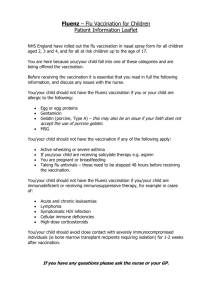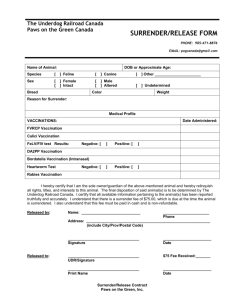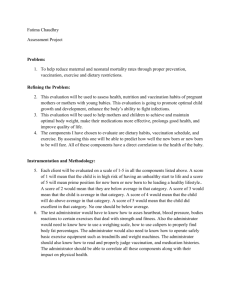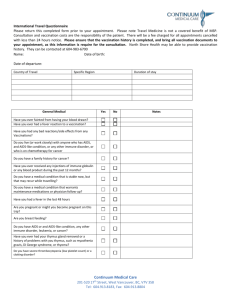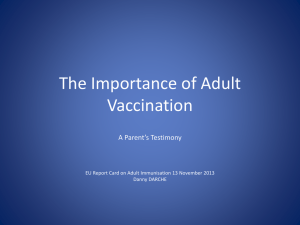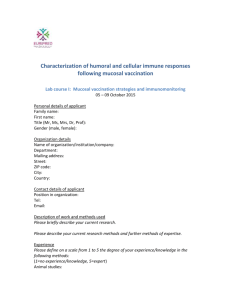Occupational Screening and Vaccination (Occupational) Against
advertisement
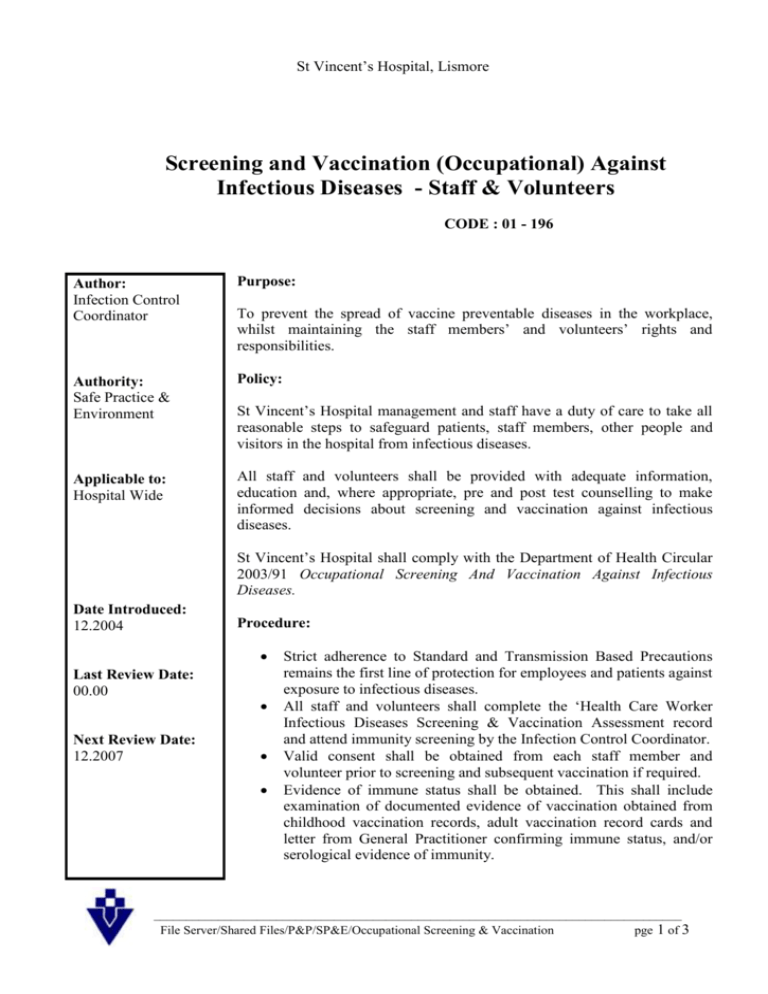
St Vincent’s Hospital, Lismore Screening and Vaccination (Occupational) Against Infectious Diseases - Staff & Volunteers CODE : 01 - 196 Author: Infection Control Coordinator Purpose: Authority: Safe Practice & Environment Policy: Applicable to: Hospital Wide All staff and volunteers shall be provided with adequate information, education and, where appropriate, pre and post test counselling to make informed decisions about screening and vaccination against infectious diseases. To prevent the spread of vaccine preventable diseases in the workplace, whilst maintaining the staff members’ and volunteers’ rights and responsibilities. St Vincent’s Hospital management and staff have a duty of care to take all reasonable steps to safeguard patients, staff members, other people and visitors in the hospital from infectious diseases. St Vincent’s Hospital shall comply with the Department of Health Circular 2003/91 Occupational Screening And Vaccination Against Infectious Diseases. Date Introduced: 12.2004 Procedure: Last Review Date: 00.00 Next Review Date: 12.2007 Strict adherence to Standard and Transmission Based Precautions remains the first line of protection for employees and patients against exposure to infectious diseases. All staff and volunteers shall complete the ‘Health Care Worker Infectious Diseases Screening & Vaccination Assessment record and attend immunity screening by the Infection Control Coordinator. Valid consent shall be obtained from each staff member and volunteer prior to screening and subsequent vaccination if required. Evidence of immune status shall be obtained. This shall include examination of documented evidence of vaccination obtained from childhood vaccination records, adult vaccination record cards and letter from General Practitioner confirming immune status, and/or serological evidence of immunity. __________________________________________________________________________________ File Server/Shared Files/P&P/SP&E/Occupational Screening & Vaccination pge 1 of 3 St Vincent’s Hospital, Lismore Medical Officers, registered nurses under medical direction, or registered nurses who are authorised to immunise under the NSW Poisons & Therapeutic Goods Act 1966 Authorisation to Supply Restricted Substances shall administer vaccines. All vaccinations shall be administered in accordance with the recommendations of the current NH&MRC Australian Immunisation Handbook. Staff and volunteers who have patient contact (Risk Category A and B, refer Appendix A) shall have an up-to-date record of immunity against hepatitis B, diphtheria, tetanus, measles, mumps, rubella, chickenpox and tuberculosis. The staff member shall be responsible for maintaining his/her own vaccination status. The Infection Control Coordinator shall retain a secure and confidential record of each staff members’ and volunteers’ pre-vaccination screening details, including date and results of all serology, date, batch number, type/brand and results of all vaccines administered. Written documentation of staff refusal to participate in screening and/or vaccination shall be retained in each staff member’s personal screening record. Each staff member shall be issued with a personal record card detailing results of all serology and vaccinations administered. Other personnel, including students, Visiting Medical Officers and contractors, must provide a documented screening and vaccination history, which must be made available to the employer prior to the commencement of their employment or clinical placement. Staff and volunteers with any communicable diseases shall consult a doctor concerning the required period of exclusion from work and notify the Infection Control Coordinator of same. Staff who are performing exposure prone procedures (the potential for direct contact between the skin and a sharp instrument in body cavities) are required to maintain a knowledge of their HIV, HBV and HCV status annually. Appendix A contains the NSW Department of Health employee risk categorisation, to guide screening and specific vaccination requirements. Related Legislation: N.S.W. Department of Health Circular 2003/91 Occupational Screening and Vaccination against Infectious Diseases NH&MRC Australian Immunisation Handbook, 8th edition NSW Department of Health Circular 2002/45 Infection Control Policy NSW Department of Health Circular 99/16 Patient Information and Consent to Medical Treatment References: NH&MRC Infection Control in the Health Care Setting, 2004 __________________________________________________________________________________ File Server/Shared Files/P&P/SP&E/Occupational Screening & Vaccination pge 2 of 3 St Vincent’s Hospital, Lismore Appendix A Risk Categorisation The following categorization of employees and ‘other personnel’ may be used to guide screening and vaccination policies. Work activities, rather than job title, should be considered on an individual basis to ensure an appropriate level of protection is provided to each employee and ‘other personnel’. Category A – direct patient contact or contact with blood or body substances All employees and ‘other personnel’ who have physical contact with, or potential exposure, to blood or body substances. Category B – indirect patient contact or contact with blood or body substances All employees and ‘other personnel’ who work in patient areas but who rarely have direct contact with patients or with blood or body substances. These employees and ‘other personnel’ may be exposed to infections spread by airborne routes, but are unlikely to be at risk from blood borne diseases. Examples include catering staff and ward clerks. Category C – laboratory personnel Laboratories contain special risk factors because of the equipment used and the possible exposure to high concentrations of microorganisms generated by culture procedures. The major risk to laboratory personnel occurs in the handling of blood and blood products. Category D – minimal patient contact Clerical staff, gardening personnel and numerous other occupational groups have no greater exposure to infectious diseases than the general public. These employees and ‘other personnel’ do not need to be included in vaccination programs or other programs aimed at protecting Category A, B, and C employees and ‘other personnel’. However, where there is public health benefit in facilitating population recommendations against vaccine preventable diseases, it is best practice to ensure all staff are appropriately immunised e.g. ADT and MMR vaccination. Summary of Screening and Vaccination Policy (Key: Y = yes, N = no, S = selected employees and ‘other personnel’) Risk Cateories Vaccine/screening A B C Adult Diphtheria and Tetanus OR Y Y Y Adult Diphtheria, Tetanus & Pertussis (acellular) S S N Hepatitis A S N N D Y N S Hepatitis B Y Y Y N Influenza Y Y Y N Measles/Mumps/Rubella Varicella (chickenpox) Y Y Y Y Y Y Y N Tuberculosis Y Y Y N __________________________________________________________________________________ File Server/Shared Files/P&P/SP&E/Occupational Screening & Vaccination pge 3 of 3

